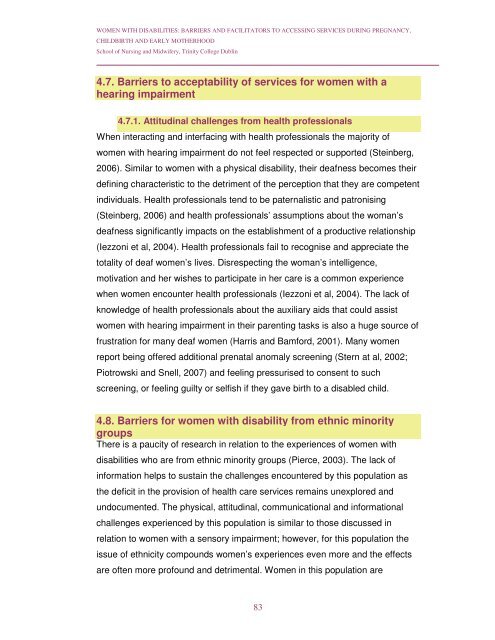Women with Disabilities: Barriers and Facilitators to Accessing ...
Women with Disabilities: Barriers and Facilitators to Accessing ...
Women with Disabilities: Barriers and Facilitators to Accessing ...
You also want an ePaper? Increase the reach of your titles
YUMPU automatically turns print PDFs into web optimized ePapers that Google loves.
WOMEN WITH DISABILITIES: BARRIERS AND FACILITATORS TO ACCESSING SERVICES DURING PREGNANCY,CHILDBIRTH AND EARLY MOTHERHOODSchool of Nursing <strong>and</strong> Midwifery, Trinity College Dublin4.7. <strong>Barriers</strong> <strong>to</strong> acceptability of services for women <strong>with</strong> ahearing impairment4.7.1. Attitudinal challenges from health professionalsWhen interacting <strong>and</strong> interfacing <strong>with</strong> health professionals the majority ofwomen <strong>with</strong> hearing impairment do not feel respected or supported (Steinberg,2006). Similar <strong>to</strong> women <strong>with</strong> a physical disability, their deafness becomes theirdefining characteristic <strong>to</strong> the detriment of the perception that they are competentindividuals. Health professionals tend <strong>to</strong> be paternalistic <strong>and</strong> patronising(Steinberg, 2006) <strong>and</strong> health professionals’ assumptions about the woman’sdeafness significantly impacts on the establishment of a productive relationship(Iezzoni et al, 2004). Health professionals fail <strong>to</strong> recognise <strong>and</strong> appreciate the<strong>to</strong>tality of deaf women’s lives. Disrespecting the woman’s intelligence,motivation <strong>and</strong> her wishes <strong>to</strong> participate in her care is a common experiencewhen women encounter health professionals (Iezzoni et al, 2004). The lack ofknowledge of health professionals about the auxiliary aids that could assistwomen <strong>with</strong> hearing impairment in their parenting tasks is also a huge source offrustration for many deaf women (Harris <strong>and</strong> Bamford, 2001). Many womenreport being offered additional prenatal anomaly screening (Stern at al, 2002;Piotrowski <strong>and</strong> Snell, 2007) <strong>and</strong> feeling pressurised <strong>to</strong> consent <strong>to</strong> suchscreening, or feeling guilty or selfish if they gave birth <strong>to</strong> a disabled child.4.8. <strong>Barriers</strong> for women <strong>with</strong> disability from ethnic minoritygroupsThere is a paucity of research in relation <strong>to</strong> the experiences of women <strong>with</strong>disabilities who are from ethnic minority groups (Pierce, 2003). The lack ofinformation helps <strong>to</strong> sustain the challenges encountered by this population asthe deficit in the provision of health care services remains unexplored <strong>and</strong>undocumented. The physical, attitudinal, communicational <strong>and</strong> informationalchallenges experienced by this population is similar <strong>to</strong> those discussed inrelation <strong>to</strong> women <strong>with</strong> a sensory impairment; however, for this population theissue of ethnicity compounds women’s experiences even more <strong>and</strong> the effectsare often more profound <strong>and</strong> detrimental. <strong>Women</strong> in this population are83
















